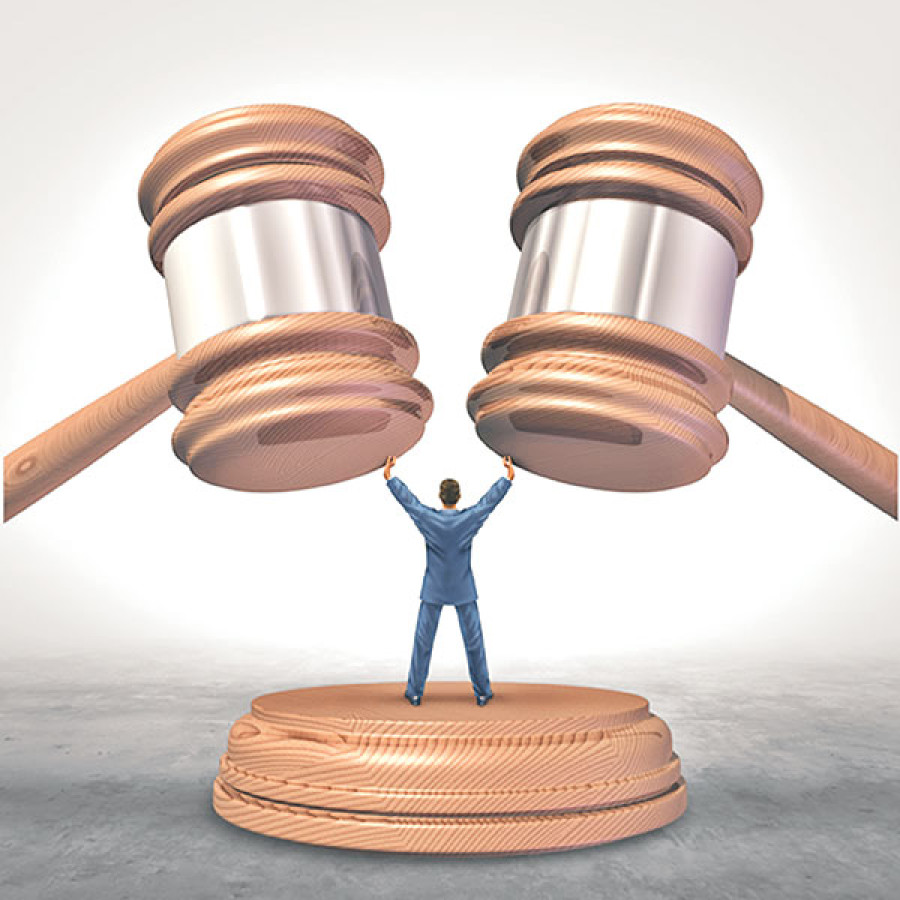Opinion
The conundrum
If Judicial Committee weren't meant to be courts and their members judges, why would they abjudicate?
Namit Wagley
Access to justice is a fundamental human right and a basic state service enshrined within the Nepali constitution. To mitigate the inefficiencies of the formal system; increase access to justice and bridge the formal/informal justice divide, the drafters of the constitution envisioned judicial committees at each of the 753 municipal and rural municipal level. Headed by deputy mayor at the municipal level and deputy chairperson at the rural municipal level, as per Article 217 of Constitution of Nepal and Local Governance Operation Act, 2017 (LGOA), the three-member committee has the mandate to settle disputes and refer cases for mediation at the local level based on their jurisdiction. The agreement or decisions can be appealed to district court and subsequently be appealed to higher courts. Judicial committees collectively exercise their jurisdiction, and the opinion of the majority is regarded as the decision of the committee. In cases of mediation, judicial committees keep a roster of trained and enlisted community mediators and refer the parties to the community mediation centres at the ward level.
In theory, the basic structure is in place for a well-oiled machine that eases the pursuit of justice for its denizens. However, in the absence of conceptual and policy clarity, guidelines and operating procedures, the function of justice delivery at the local level is suffering from a lot of inconsistencies and confusion.
In the current scenario, elected representatives are new and inexperienced. Some of them lack knowledge and experience in administrative, managerial and judicial processes. Due to their political affiliations, reports have started to emerge highlighting politicisation of the dispute resolution process. The overburdening of judicial work has also affected their meaningful participation across the various tiers of local government (i.e. legislative, executive and judiciary). In other areas, judicial committees have been found to be handling disputes outside their jurisdiction. To exasperate matters further, constitution and current legislative frameworks fail to establish adequate support and quality control mechanisms to sustain high quality dispute resolution services. This raises fears that the poor and marginalised will continue to be ostracized; politicisation and corruption will continue to persist; even in the new federal setup.
What needs to be done?
First and foremost, there needs to be a common understanding on the conceptual framework of judicial committees. The framers of the Constitution clearly did not envision judicial committees to be a court. If they had, they could have easily called it “local courts.” Similarly, judicial committees aren’t part of an integrated judicial system (i.e. district, appellate and supreme court) as they aren’t governed by judicial council and house elected representatives as members of the committees as opposed to judicial officers and judges. In addition, if we look at the traditional history of our justice systems at the local level, we had practices of settling disputes at the local level through panchayat led judicial committees as per the Village Panchayat Act, 1961. They were not considered courts, rather an alternative to the integrated judicial system that supplemented access to justice.
Second, the whole debate on the process and premise of “settling disputes” needs to be resolved. It is quintessentially an adjudication versus. arbitration question. Traditionally, alternative local systems exercised the mandate to mediate or arbitrate pre-defined classification of cases. In 1999, Local Self Governance Act, (LSGA) provisioned a med-arb concept to hear and settle cases relating to land, trespass, paupers etc. at the VDC level. The main feature of a med-arb approach is that it encourages parties to resolve their disputes through mediation. If that does not resolve it, then the process switches to a binding arbitration. Currently, the LGOA propositions a similar structure, however, in practice—the premise of settling disputes have been misinterpreted to mean litigatory adjudication.
This raises a whole host of issues ranging from separation of powers, competence, fairness and equality in legal process to being contrary to the premise of access to justice. The underlying question remains: If judicial committees weren’t meant to be courts and judicial committee members judges, why would they adjudicate? Even if we entertain the fact that judicial committees should be allowed to adjudicate, then adequate oversight, support and guidance mechanism needs to be established—in policy and practice. Whilst doing so, it is imperative that local dispute resolution process rid itself of all the complexities and
procedural hassles, inherent in the formal justice sector, whilst not compromising due process and thereby justice at the local level.
Third, the interface between judicial committees at the rural municipal and municipal level and community mediation at the ward level needs to be institutionalised. As a key cog of ensuring social harmony and holistic justice, community mediation needs to work in tandem with judicial committees. This will not only reduce the case settlement burden on judicial committees but truly allow citizens to access justice at their doorsteps. If we look at the spirit of the Constitution and the LGOA, mediation is given utmost priority as the pre-dominant form of dispute resolution at the local level. Judicial committees supplement
that with arbitrating cases that cannot be resolved through mediation. In recent times, a debate has emerged whether judicial committees can mediate cases themselves.
Multi-faceted intervention
This can be problematic for a variety of reasons. One, mediation and arbitration are specialised disciplines that require different skill set and procedures to resolve cases. Two, Mediation Act, 2011 has clearly stipulated the criteria to become a community mediator, one needs to attain 25 years of age and complete an eight-day training to be eligible. Even if we argue that should parties want, they can choose anyone as mediators irrespective of their age and credentials, having judicial committees mediate cases will raise issues of confidentiality and due process- -contrary to a mediator’s code of conduct. If the mandate of judicial committees is expanded to include mediation, there is a potential of conflict of interest for them to resolve the same case through arbitration should mediation not yield a resolution. Therefore, the scope of conflict of interest needs to be coherently defined to address issues of politicisation; balance separation of powers; maintain synergy between judicial committees and mediation, and demonstrate transparency and accountability.
Whilst impending regulations on Local Governance Operation Act will provide further clarity, institutionalising judicial committees will require multi-faceted interventions. From designing coherent policy frameworks; supplementing holistic trainings and practice sharing for committee members; developing physical infrastructure—for judicial committees at the municipal and rural municipal level and mediation centers at the ward level; establishing quality control and judicial oversight mechanisms; creating linkages with other access to justice service providers (such as town police, shelter homes, human rights based NGOs, quasi-judicial bodies) to installing integrated judicial support systems—such as legal officer and legal assistant to provide administrative and technical support (i.e. screening cases, registering disputes, drafting agreement papers etc.) to committee members at the local level.
Wagley holds a LLB and LLM in International Law and Human Rights from University of Sussex, UK




 7.12°C Kathmandu
7.12°C Kathmandu










